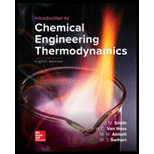
Interpretation:
The quality of steam in its initial state should be deduced based on the given initial and final conditions of steam.
Concept Introduction:
- For a two-phase liquid-vapor equilibrium mixture the specific volume (V), enthalpy (H) and entropy (S) are given as:
- For a process that takes place at constant enthalpy, the change in enthalpy is zero. In other words, the enthalpy in the final state (H2) is equal to that in the initial state (H1). The change in enthalpy is given as:
Quality of steam in the initial state = 0.953
Given:
Initial pressure of wet steam, P1 = 1100 kPa
Final pressure P2 = 101.33 kPa
Final Temperature of steam =
Explanation:
Since this is a constant enthalpy process, H2 = H1
The final state enthalpy (H2) can be deduced by interpolation based on the steam table data for saturated steam and superheated steam at 101.33 kPa. Finally, the initial state steam quality (x) can be deduced based on equation (2) and known values of the initial state Hg and Hffrom the steam tables.
Calculation:
Step 1:
Calculate the final state enthalpy
Based on the steam tables at the final state pressure = 101.33 kPa we have:
For saturated steam:
Saturation temperature, T =
Specific enthalpy of vapor, Hg = 2675.6 kJ/kg
For superheated steam:
Saturation temperature, T =
Specific enthalpy of vapor, Hg = 2776.6 kJ/kg
Thus the enthalpy at final state T =
Step 2:
Calculate the initial state steam quality
Since, H2 = H1 We have, H1 = 2685.8 kJ/kg
Based on the steam tables at the initial state P = 1100 kPa we have:
Specific enthalpy of vapor, Hg = 2780.7 kJ/kg
Specific enthalpy of liquid, Hf = 781.0 kJ/kg
Based on equation (2) we have for the initial state enthalpy:
The quality of steam in the initial state is, x = 0.953
Want to see the full answer?
Check out a sample textbook solution
Chapter 6 Solutions
Introduction to Chemical Engineering Thermodynamics
 Introduction to Chemical Engineering Thermodynami...Chemical EngineeringISBN:9781259696527Author:J.M. Smith Termodinamica en ingenieria quimica, Hendrick C Van Ness, Michael Abbott, Mark SwihartPublisher:McGraw-Hill Education
Introduction to Chemical Engineering Thermodynami...Chemical EngineeringISBN:9781259696527Author:J.M. Smith Termodinamica en ingenieria quimica, Hendrick C Van Ness, Michael Abbott, Mark SwihartPublisher:McGraw-Hill Education Elementary Principles of Chemical Processes, Bind...Chemical EngineeringISBN:9781118431221Author:Richard M. Felder, Ronald W. Rousseau, Lisa G. BullardPublisher:WILEY
Elementary Principles of Chemical Processes, Bind...Chemical EngineeringISBN:9781118431221Author:Richard M. Felder, Ronald W. Rousseau, Lisa G. BullardPublisher:WILEY Elements of Chemical Reaction Engineering (5th Ed...Chemical EngineeringISBN:9780133887518Author:H. Scott FoglerPublisher:Prentice Hall
Elements of Chemical Reaction Engineering (5th Ed...Chemical EngineeringISBN:9780133887518Author:H. Scott FoglerPublisher:Prentice Hall
 Industrial Plastics: Theory and ApplicationsChemical EngineeringISBN:9781285061238Author:Lokensgard, ErikPublisher:Delmar Cengage Learning
Industrial Plastics: Theory and ApplicationsChemical EngineeringISBN:9781285061238Author:Lokensgard, ErikPublisher:Delmar Cengage Learning Unit Operations of Chemical EngineeringChemical EngineeringISBN:9780072848236Author:Warren McCabe, Julian C. Smith, Peter HarriottPublisher:McGraw-Hill Companies, The
Unit Operations of Chemical EngineeringChemical EngineeringISBN:9780072848236Author:Warren McCabe, Julian C. Smith, Peter HarriottPublisher:McGraw-Hill Companies, The





